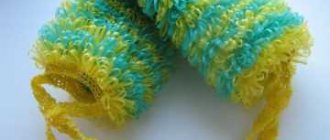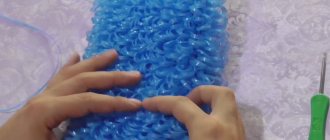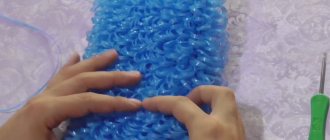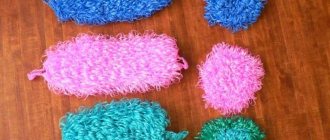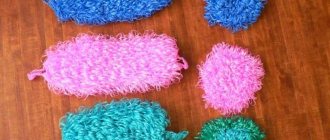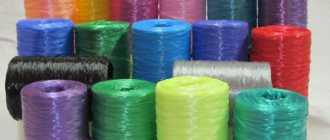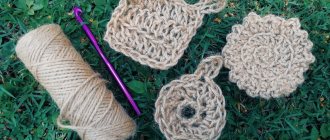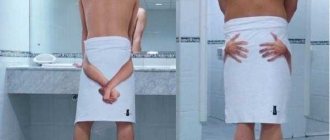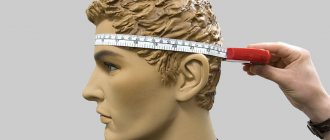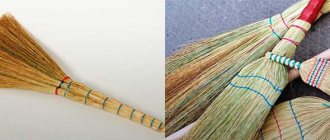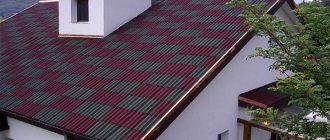There is no way to do without such a necessary thing as a simple washcloth in the household. We simply need it in everyday life. It is impossible to live without it in the bathroom and kitchen. There are many types of washcloths, such as smooth, fluffy, straight, cylinder-shaped, and round. There is a large selection of these products of all types in the trading network, but you can not spend money from your home budget and knit any one you like with knitting needles.
This type of knitting will not require large material costs, because you will only need synthetic threads and knitting needles (hosiery or with stoppers). In this article you will learn how to knit washcloths of several common types. This is a straight, elongated loop (P), a cylindrical and round pipe. Such products are knitted from fairly stiff synthetic yarn. To conclude the article, we will talk about smooth washcloths knitted using fabric strips.
Master class for beginners: how to knit a fluffy washcloth
To work you will need:
- synthetic threads, better in bright colors;
- straight sp. No. 3 (select according to the thickness of the yarn).
Description
We cast on with knitting needles 30 stitches. and knit 5p. persons satin stitch
From the 6th p.m. We begin knitting elongated loops. We remove the first loop, and knit the second one like this: we hook the sp loop, as when knitting faces. satin stitch, and place the thread on top of the stitch lying on the finger.
We wrap the sp. and finger twice with yarn and knit faces. p. We knit the next p. with a regular knit stitch. Until the end of the row, we alternate knitting elongated loops and regular ones.
The master class in the photo will help you understand the technique of knitting elongated loops more clearly.
7th row: 1p. remove, the rest - persons.;
8 rubles: like the 6th rub;
Using this pattern, we knit a washcloth of the required length.
At the end we switch to faces again. Ch. Knit 5p with this pattern.
For ropes along the edges you need to tie two strips. We cast on with knitting needles 40 sts. and knit 3p. persons satin stitch We close the loops. Sew stripes along the edges of the product.
Extended loops
Knitting washcloths with knitting needles with elongated loops is a popular option. Even a beginner can master it. It is important to note that with this method, yarn consumption increases significantly. For this pattern, the “pipe” washcloth model is preferable, when the fabric is knitted in the round. Cast on 30 stitches on circular needles and close into a circle. Knit 4-5 rows with knit stitches.
Start knitting long loops from the next row. Knit 1, then put the thread on the thumb of your left hand, located in front of the work, and, without removing the yarn over, knit a knit stitch. Repeat alternating long and knit stitches until the end of the row. The next row is knitted to secure the elongated loops. Repeat this way until the desired length. Knit the last 4-5 rows. Attach ribbons for hanging, and the washcloth is ready.
Article on the topic: How to remove a poker from a newborn in a bathhouse
How to get a shaggy loofah? Just. Knitting a washcloth with knitting needles is done by pulling out the loops, as mentioned above.
When knitting, you can alternate colors, making bright stripes, or make a simple pattern.
Sponge - pipe
This option can be knitted using circular knitting. We dial 32p. and switch to knitting in the round with 5 knitting needles. We distribute loops 8 pieces per joint. Further - see the previous master class: several rows of faces. satin stitch, then elongated loops, then knit again. Ch. And be sure to tie the ropes. If desired, they can be replaced with ready-made ribbons to match the color of the yarn.
You can put a piece of foam rubber inside (the edges of the pipe are then sewn up). This washcloth will foam perfectly.
How to knit a round washcloth
This wonderful massage sponge consists of two parts: a handle and a round base.
Pattern used:
- garter stitch.
Description
Cast on 20(30) sts and knit the length of the fabric. It should be several times larger than the width. If at the beginning of every second row you add 1 stitch, and at the end you knit from 2 stitches. one, then we will get a slightly beveled product - this solution also looks very nice. For a round pen, dial 5p. and knit 15-17cm long. Pull the free end of the lace on one side and sew tightly. We do the same on the second side. We connect both ends and sew them together. We get a washcloth in the form of a circle.
Knitting needles. Shape and size
Fine yarn is not used for washcloths. Therefore, you need to choose the appropriate knitting needles - No. 5-8. The denser the pattern is, the tighter the curl will be.
Before you start knitting a washcloth, you need to decide on the size and shape of the future product. In this case there are no strict restrictions. For children, you can knit a curl in the form of a fun toy. The shape of the washcloth depends on preference: you can make it round, rectangular or in the form of a pipe. You can knit a mitten or mitten. It all depends on the wishes of the craftswoman or the customer.
Massage washcloth made from strips of fabric
For this washcloth, you can use strips of fabric cut from old tights or any old synthetic items. It's better if it's at least two different colors. This knitting is best done with large knitting needles, approximately No. 7.
Master Class
Cut ribbons of fabric and roll it into a ball. Cast on with knitting needles 11 stitches. and knit 8p. garter stitch.
Change the color of the threads and knit 10 rubles. shawl pattern. Then we knit 28 rubles with light yarn. We change the color twice more: 10 rubles. light, 8 rub. – dark. Close the loops by knitting 2 stitches. in 1p.
At the end of the washcloth, tie three strips of fabric and weave them into a braid 35 cm long. At the other end, make the same braid.
We knit a washcloth for washing dishes
The finished size of the product is about 10cm in diameter.
To work you will need:
- yarn (can be of different colors) -20g;
- yarn for auxiliary thread;
- sp. No. 4;
- scissors;
- needle with a large eye.
Master Class
We start knitting a washcloth from a set of knitting needles 27p. auxiliary thread.
Let's move on to the main yarn.
1st: facial.
Knitting the 2nd r. and subsequent ones, we shift the loops - see the master class in the photo:
2p.: 2p. at the beginning of the row, knit in 1 stitch.
Knit the entire row, except for the last stitch. p. Before the outermost p., make a crossed yarn over (so that there are no holes in the fabric) and knit the outermost p.
3rd: persons;
4r.: like 2nd r.
We knit it to the desired height - this is 42 rubles, alternating the 1st and 2nd rows. If you use yarn of different colors, alternate them in your work as you wish. For example, for 2 thread colors, the first 11p. We do it with the 1st color (the very first row does not count - it is for sewing the washcloth). Change the color of the yarn without cutting the thread of the first color.
We knit 10 rubles with the second color. Again we change the color of the threads - another 10 rubles. So we alternate our two colors. On the last section, do 11 rubles. (add 1 p. for stitching). Only 42 rub.
We remove the auxiliary thread, transferring the loops to the knitting needle.
We fold the product, combining the first and outer rows of work.
We cut off the thread with a margin and sew the fabric with it.
We get this design - a pipe:
We tighten both holes at the ends and flatten the washcloth. To do this, we make a running stitch on the edge of the holes along the circumference. See the master class on tightening the top edge in the photo. After tightening the thread, leave the edge long.
We turn the washcloth over and hide all the unnecessary ends of the threads inside. We tighten the bottom.
Flatten the product into a circle, aligning both holes. We take out both threads used to sew the top and bottom to one side and tie them tightly together to fix the center. If you leave long ends, you can crochet a loop from them.
All! The washcloth is ready!
Secrets of a simple but beautiful knitting of a bath accessory
Materials
Today the market is replete with all kinds of knitting materials. But the choice is not so easy to make. It is especially difficult for beginner needlewomen. I will talk about popular raw materials intended for knitting washcloths.
An excellent material is bast. It consists of linden fibers extracted from the inside of the tree and combined into threads. Washcloths knitted from natural raw materials:
- durable and wear-resistant;
- practical and environmentally friendly;
- lathers well and smells good;
- have a beneficial effect on the body;
- They cleanse the skin well of impurities and dead cells.
Thus, products made from bast must certainly be present in the bath suitcase of steam gourmets!
A good material for creating a bath accessory is a loofah. The washcloth is known for its rigidity, which is why it has an anti-cellulite, regenerating, cleansing, exfoliating and stimulating effect on the skin. In addition, the product has a long service life and washes well.
The perfect raw material for making bath accessories is flax. It was from this that red maidens and good fellows living hundreds of years ago made washcloths that were used in the steam room. The product is different:
- wear resistance;
- long service life;
- hypoallergenic;
- environmental cleanliness;
- pleasant aroma;
- healing effects on the body;
- excellent lathering;
- good water absorption.
The linen accessory must be watered with hot water before use, as it is very hard.
A good material for making a washcloth is sisal - this is a tropical plant, the fiber of which is known for its increased rigidity. The bath accessory should not be used more than twice a week, because it can damage the skin.
It has excellent cleansing, activating, stimulating and regenerating properties. It also does not suffer from demolition, since it resists the destructive effects of negative environmental factors. However, if your man has sensitive skin, do not give him a bath item made of sisal.
DIY bath accessories
Ramie is an excellent material for making a “bath assistant”. What is this? Ramie is a Chinese nettle, the fibers of which produce products of medium hardness. They are equally good for all skin types. The washcloths wash well and absorb water perfectly. In addition, the raw materials have anti-inflammatory, cleansing, rejuvenating, and protective effects. The product also has a long service life.
An amazing material for making washcloths is birch bark. The accessory can not only cleanse the skin, but also give it an impeccable condition. In addition, the washcloth washes well, absorbs water well and dries quickly.
And, of course, the accessory can be made from artificial raw materials that are not susceptible to the destructive effects of negative factors. In addition, the color palette of the material is mind-blowing! But you need to know that synthetics can negatively affect human health.
As you can see, the selection is impressive! I think now you can purchase material with which you can knit a luxurious washcloth.
